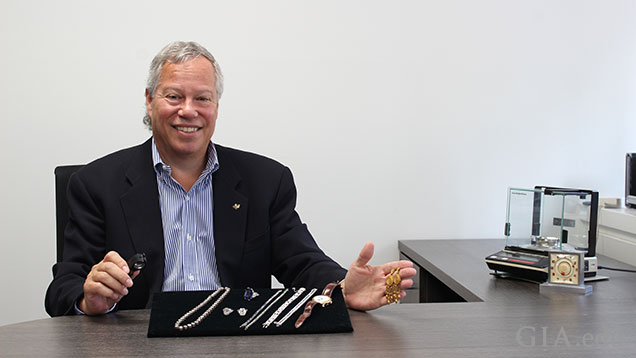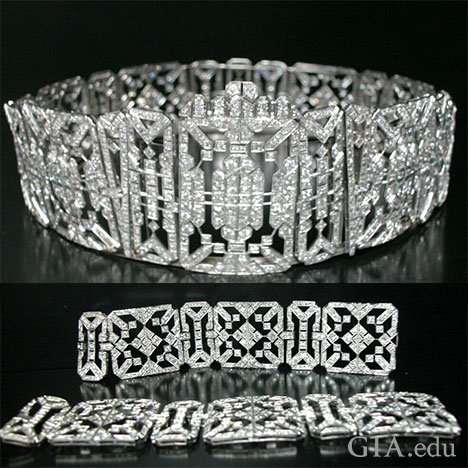Alum’s Lifelong Quest: Searching for Jewelry Unicorns
August 14, 2019

Alan Nacht is on a never-ending quest to find the “jewelry unicorn” – a piece of great beauty and value that has somehow gone unnoticed.
This quest motivates Nacht as he starts every workday – and if his enthusiasm ever wanes, all he has to do is remember the jewelry unicorns he’s found in the past.
Take the modern bangle bracelet studded with 10 cushion-shaped sapphires and small round diamonds Nacht saw on a buying trip several years ago. Looking more closely at the piece, he noticed that the cut of the sapphires was far older than the bracelet. So he bought it and later learned that his hunch was right: the sapphires were from the legendary locale of Kashmir.

Another time, Nacht was having lunch with the owner of a well-known antique jewelry store in London who showed him a French tutti fruitti bracelet glittering with a large Asscher cut diamond set in the clasp and asked, “Alan, do you think that the diamond is pink?”
“Yes, and please give me an invoice,” Nacht said, later finding out that the 1.12 carat diamond was a Fancy Pink.
“Luck and longevity in the business go hand-in-hand to find the elusive jewelry unicorn,” Nacht said. “There are items that have intrinsic value and little material value. Others have material value and little intrinsic value. The unicorn is the piece that wakes up all that you have experienced, talked and learned about and dreamed of seeing. And there it is right in front of you!”

All quests have their beginnings. This one started in 1906, when Nacht’s grandfather founded Bernard Nacht & Co. in lower Manhattan. The elder Nacht was one of the pioneers in the second-hand diamond and jewelry market in New York City. Nacht’s father eventually took over and taught his son the business from the time he was a young boy, resulting in an informal apprenticeship in the diamond trade.
At the end of his school day and during vacations, Nacht ran errands for the family business. Stops included visits to diamond setters, polishers, manufacturers, lapidaries and diamond cutters. He asked questions and soaked up the answers.

After earning a B.S. in finance and insurance from Syracuse University, Nacht started working at the family business, knowing a GIA education figured in his future. Nacht’s father was friendly with Robert Crowningshield, one of the towering figures in GIA’s history, and encouraged his son to take classes at the Institute.
“I knew I needed to learn the educational side of the gem business, and I also knew that the best place to study was at GIA. Courses were offered at night, so I was able to work during the day and learn in the evening,” Nacht said.
Nacht studied Graduate Diamonds and Gem Identification and said that learning how to identify gems is an invaluable skill in his line of work, one he uses daily.
“Gem identification is essential in the estate jewelry world,” Nacht said. “What I learned at GIA, plus my years of experience, makes it possible for me to create a mental checklist when I evaluate a piece.”
GIA gave Nacht more than an education. He formed a lifelong friendship with Doug Parker, one of his now-retired instructors. In fact, Parker and his wife attended Nacht’s wedding and are still friends and business associates.
“I always say, ‘It is not what you know, but who you know.’ Meeting others who share your common passion creates tremendous opportunity,” Nacht said.

Bernard Nacht & Co. is now a fourth-generation business. Nacht, the president and CEO, works alongside two of his adult children Ross and Bari, who help with sales, purchasing, brand and product development, inventory, the web/internet and social media. The company’s primary focus is estate jewelry, but they have extended the brand in several creative ways.
Their newest venture is the Crown Jubilee diamond – a trademarked proprietary cut used to recut old mine and old European Cut diamonds. The cut has no table and a unique facet arrangement. Another offering, Under the Crown Jewelry, is a branded, trademarked collection that features a large range of estate jewelry, reclaimed diamonds and vintage engagement rings.

Bernard Nacht & Co. has also purchased the trademarks of other jewelry houses, such as Castellani Jewellers and Carlo Giuliano, two well-known jewelry houses of the Victorian era. Nacht purchased both companies and trademarked both brands, and they continue to manufacture Etruscan-style jewelry.
Nacht always comes prepared. He carries a loupe in the field and has a refractometer, polariscope, long and short wave blacklight and microscope in his office. He is fascinated with inclusions and uses them to make an educated guess about a gemstone’s geographical origin. In fact, gemstone dealers often ask Nacht to identify their gemstones.
Nacht is steadfast in his goal to nurture his family’s legacy, a business that has been in operation in Manhattan, one of the world’s most competitive gem and jewelry capitals, for 113 years. He attributes the company’s success to staying true to its mission while looking for innovative opportunities that complement it.
And Nacht is still on the quest for jewelry unicorns – hoping to find that unforgettable piece in search of a new home.



